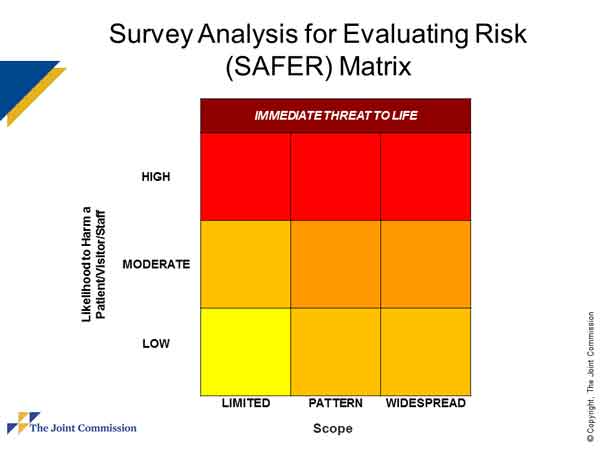If you are a psychiatric hospital using TJC accreditation for deemed status, you know that TJC recently implemented some significant changes to its survey process and scoring methodology. These include closer scrutiny of the two Special Conditions of Participation for psychiatric hospitals (B Tags) and use of the SAFER (Survey Analysis for Evaluating Risk) matrix for survey reports. The SAFER matrix summarizes survey findings based on the estimated level of risk to patients, staff, and visitors. It is displayed as a 9 box grid summarizing the survey findings based on the likelihood of harm and the scope of non-compliance.

Some of our clients have now been surveyed since these changes went into effect and so we are sharing highlights from their survey experiences and outcomes. First, in regard to the survey process (and as reported in earlier issues of our newsletter) there is increased scrutiny of the CMS CoPs for treatment planning. There have been deficiencies cited (some at the Condition level) under both the A Tag for the Medical Record Services CoP (A-0431) and the B Tag for the Special Medical Record Requirements for Psychiatric Hospitals CoP (B-103.) The findings include lack of measurability of goals/objectives, lack of specific treatment modalities, plans not individualized, inadequate documentation of progress, and lack of revision to treatment plans. In regard to active treatment (another high scrutiny area,) RFIs have focused on lack of alternative treatment for patient who did not attend groups as well as inadequate documentation of progress in group notes for patients who did attend groups.
In regard to how scoring is displayed on the SAFER matrix, we have thus far not seen any hospital that had findings in the upper right hand corner of the grid (high likelihood of harm to patient and widespread scope of non-compliance.) We have seen a significant number of findings placed in the Low Risk/Limited category. We have also seen many findings placed in the Moderate Risk category with their scope evenly spread across the designations of Limited, Pattern, and Widespread. In terms of what constitutes a scope of non-compliance that is designated as a Pattern or Widespread versus Limited, we have seen findings that cite 3 of 5 records and 3 of 8 records as non-compliant and placed in the Pattern category. When all records reviewed (e.g. 8 of 8) were found non-compliant, the finding was designated as Widespread.
Examples of scoring are as follows:
- One medication order not authenticated by the prescriber: Low Risk/Limited
- 5 of 8 records; no specific treatment modalities for medical conditions: Moderate Risk/Pattern
- 7 of 7 records; inadequate description of progress toward goals/objectives: Moderate Risk/Widespread
For findings that are designated at the higher risk levels, the response to TJC now requires additional information about leadership involvement in addressing the issue and how compliance will be sustained.
In regard to Condition level deficiencies, we have seen those cited for the following CoPs: Medical Records, Physical Environment, Medical Staff, Staffing, Infection Control, and Governing Body. It’s important to note that even findings not designated as High Risk and Widespread can result in Condition level deficiencies. Condition level deficiencies require a TJC follow-up survey within 45 days.
Lastly, new elements added to the survey process have included review of a record of a patient death, more extensive review of records taking place off of the units (in addition to the records reviewed during tracers) and lengthier observations of active treatment on the units. (For additional discussion of the review of active treatment, see our June newsletter.)
As you can see, we are staying abreast of these important changes that impact our clients. We have modified our tools and techniques to cover the newly emerging issues and will continue to keep you posted on important developments.

